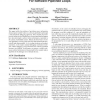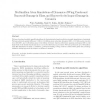2020 search results - page 33 / 404 » Scalable Instruction-Level Parallelism. |
MICRO
1998
IEEE
14 years 1 months ago
1998
IEEE
The Multiscalar architecture advocates a distributed processor organization and task-level speculation to exploit high degrees of instruction level parallelism (ILP) in sequential...
MICRO
1997
IEEE
14 years 1 months ago
1997
IEEE
As processors continue to exploit more instruction level parallelism, a greater demand is placed on reducing the e ects of memory access latency. In this paper, we introduce a nov...
PLDI
1996
ACM
14 years 1 months ago
1996
ACM
High performance compilers increasingly rely on accurate modeling of the machine resources to efficiently exploit the instruction level parallelism of an application. In this pape...
CASES
2007
ACM
14 years 26 days ago
2007
ACM
This paper tackles the problem of providing correct information about program variable values in a software-pipelined loop through a non-transparent debugging approach. Since mode...
CPHYSICS
2007
13 years 8 months ago
2007
We have developed scalable parallel algorithms for first-principles based predictive atomistic simulations of materials.


